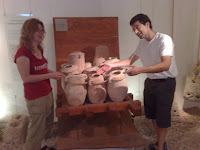Heiko worked the last 6 years towards his PhD. He did a lot of things during this time – and even though not everything was on his PhD topic – I think the time was well spent, e.g. some visually interesting things came out [1].
 The core of his PhD was on eye gaze as an additional modality for human computer interaction and it is worthwhile to read the thesis (which will be available in a few weeks) – till than you can have a look at the following papers. [2] describes a system that positions the mouse pointer on touching the mouse to the location on the screen where look at; [3] introduces the concept of gaze gestures – gestures done with the eyes. There is an interesting alt.chi paper coming on Fitts‘ law (don’t start Heiko on this ;-).
The core of his PhD was on eye gaze as an additional modality for human computer interaction and it is worthwhile to read the thesis (which will be available in a few weeks) – till than you can have a look at the following papers. [2] describes a system that positions the mouse pointer on touching the mouse to the location on the screen where look at; [3] introduces the concept of gaze gestures – gestures done with the eyes. There is an interesting alt.chi paper coming on Fitts‘ law (don’t start Heiko on this ;-).
In the evening Raphael showed me his interactive surface prototype [4] – it is really big :-). He is also co-organizing a course on Sketching with Hardware.
[1] Heiko Drewes. Yara – Yet Another Random Art.
[2] Drewes, H. and Schmidt, A. 2009. The MAGIC Touch: Combining MAGIC-Pointing with a Touch-Sensitive Mouse. In Proceedings of the 12th IFIP TC 13 international Conference on Human-Computer interaction: Part II (Uppsala, Sweden, August 24 – 28, 2009). Lecture Notes In Computer Science, vol. 5727. Springer-Verlag, Berlin, Heidelberg, 415-428. DOI= http://dx.doi.org/10.1007/978-3-642-03658-3_46
[3] Heiko Drewes, Albrecht Schmidt. 2007. Interacting with the Computer using Gaze Gestures. In Proceedings of the 11th IFIP TC13 International Conference on Human-Computer Interaction, INTERACT 2007, Rio de Janeiro, Brazil, September 2007, ISBN 978-3-540-74794-9, DOI= http://dx.doi.org/10.1007/978-3-540-74800-7_43
 [4] Raphael Wimmer, Florian Schulz, Fabian Hennecke, Sebastian Boring, Heinrich Hussmann. Curve: Blending Horizontal and Vertical Interactive Surfaces. Adjunct Proceedings of the 4th IEEE Workshop on Tabletops and Interactive Surfaces (IEEE Tabletop 2009), Banff, Canada, Nov. 2009
[4] Raphael Wimmer, Florian Schulz, Fabian Hennecke, Sebastian Boring, Heinrich Hussmann. Curve: Blending Horizontal and Vertical Interactive Surfaces. Adjunct Proceedings of the 4th IEEE Workshop on Tabletops and Interactive Surfaces (IEEE Tabletop 2009), Banff, Canada, Nov. 2009









